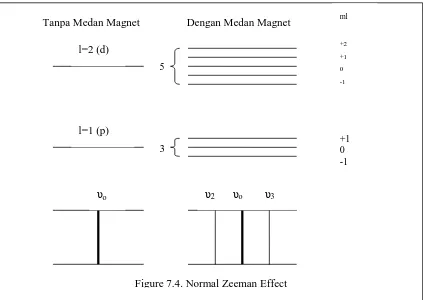CHAPTER 7 ZEEMAN EFFECT
A. Introduction
Gambar 7.1. Pieter Zeeman
What happens if atom is placed in magnetic field? In external magnetic field B, magnetic dipole has potential energy of Vm which its value depend on magnetic dipole and orientation of magnetic dipole from external magnetic field as shown in Figure 7.1 as follow:
Figure 7.1. Magnetic dipole moment has an angle of θ from magnetic field B
Torque which exerts in magnetic dipole moment in external magnetic field Bis:
xB Bsin (7.1)
θ
This torque will be maximum if the magnetic dipole moment is perpendicular from the direction of magnetic field, and will be zero if it is parallel or anti parallel from the direction of magnetic field.
B. Magnetic Potential Energy
To determine value of potential energy Vm it must be determined the reference configuration (example: it is taken Vm=0 for 90o, in this case is perpendicular direction with external magnetic field.
C. Magnetic Moment of Current Loop
Because of magnetic motion of orbital electron in hydrogen atom depends on angular momentum L, and the direction of Lfrom magnetic field, it gives a contribution in total energy of atom if atom is placed in external magnetic field. Magnetic moment of current loop is:
A I
(7.3)
where I is electrical current, and A is the area surrounded by the current loop. Electron has rotation frequency of in circular orbit of r proportional with current of -e υ (because charge of electron is –e), and its magnetic dipole moment is:
2
r e
(7.4)
Linear speed of electron is, so the value of orbital momentum of electron is:
L
giromagnetik. The minus sign (-) show that the direction of magnetic dipole moment of orbital electron in opposite direction with the direction of angular momentum L. The formulae of magnetic dipole moment of orbital electron in equation (7.6) is obtained classically, and the fact that quantum mechanics gives the sma result. It means that magnetic potential energy of atom which placed in external magnetic field is:
Selanjutnya berpijak pada Gambar 7.2 berikut dapat dilihat bahwa sudut antara L dan z hanya boleh memiliki harga tertentu yang memenuhi hubungan:
1The value of angular momentum which permitted is:
1 l l
L
Substitute equation (7.8) in equation (7.7) is resulted magnetic energy of atom which placed in external magnetic field:
B
which is called as Bohr magneton.
So in external magnetic field, a certain energy states of atom depend on magnetic quantum number of ml and principal quantum number of n. State with principal
quantum number n will be splitted in several substates if atom is placed in external magnetic field and its energy undergoes shift to be lower or higher compared without magnetic field. That phenomenon cause the splitting of single line spectral (singlet) to be triple line spectral (triplet) if atom placed in external magnetic field. The distance among the lines spectral depend on the intensity of magnetic field B.
+2ħ
D. Zeeman Effect
The phenomenon of the splitting of line spectral which caused by atom placed in external magnetic field is called Zeeman effect. This term is taken from the name of physicist of Zeeman who observed this phenomenon in 1896. Zeeman Effect is a clear proven of space quantification.
Because mlcan have value of (2l+1), from +l pass through 0 until –l, so the state
with orbital quantum number of l is splitted to be (2l+1) sub states which have difference energy of BBif atom placed in external magnetic field. Nevertheless, because of the difference of mlis limited at ml 0, 1, so we can hope spectral lines
which resulted by transition between two states with different l is only splitted to be three component. Normal Zeeman effect consist of spectral lines with frequency of oto be three component of frequency:
m eB B
o B
o
4
1
(7.10)
o
2 (7.11)
m eB B
o B o
4
1
(7.12)
In Figure 7.3 is presented single line is splitted to be three lines in Zeeman effect.
Figure 7.3. Zeeman Effect
E. Reference
Beiser, A. 1987. Concept of Modern Physics, Fourth Edition. McGraw-Hill, Inc.
Sune Svanberg. 1992. Atomic and Molecular Spectroscopy. Second Edition. Berlin: Springer-Verlag.
Stephen Gasiorowicz. 1995. Quantum Pysics. Second Edition. New York: John Wiley and Sons Inc.
Yusman Wiyatmo. 2008. Fisika Atom dalam Perspektif Klasik, Semiklasik, dan Kuantum. Yogyakarta: Pustaka Pelajar
l=1 (p) l=2 (d)
ml
+2 +1 0 -1
+1 0 -1
υo υ2 υo υ3
Tanpa Medan Magnet Dengan Medan Magnet
Figure 7.4. Normal Zeeman Effect
5




